Thiamine metabolism genes in diatoms are not regulated by thiamine despite the presence of predicted riboswitches
- PMID: 35653609
- PMCID: PMC9544697
- DOI: 10.1111/nph.18296
Thiamine metabolism genes in diatoms are not regulated by thiamine despite the presence of predicted riboswitches
Abstract
Thiamine pyrophosphate (TPP), an essential co-factor for all species, is biosynthesised through a metabolically expensive pathway regulated by TPP riboswitches in bacteria, fungi, plants and green algae. Diatoms are microalgae responsible for c. 20% of global primary production. They have been predicted to contain TPP aptamers in the 3'UTR of some thiamine metabolism-related genes, but little information is known about their function and regulation. We used bioinformatics, antimetabolite growth assays, RT-qPCR, targeted mutagenesis and reporter constructs to test whether the predicted TPP riboswitches respond to thiamine supplementation in diatoms. Gene editing was used to investigate the functions of the genes with associated TPP riboswitches in Phaeodactylum tricornutum. We found that thiamine-related genes with putative TPP aptamers are not responsive to supplementation with thiamine or its precursor 4-amino-5-hydroxymethyl-2-methylpyrimidine (HMP), and targeted mutation of the TPP aptamer in the THIC gene encoding HMP-P synthase does not deregulate thiamine biosynthesis in P. tricornutum. Through genome editing we established that PtTHIC is essential for thiamine biosynthesis and another gene, PtSSSP, is necessary for thiamine uptake. Our results highlight the importance of experimentally testing bioinformatic aptamer predictions and provide new insights into the thiamine metabolism shaping the structure of marine microbial communities with global biogeochemical importance.
Keywords: Phaeodactylum tricornutum; CRISPR/Cas9; TPP riboswitch; aptamer prediction; diatoms; thiamine biosynthesis; thiamine uptake.
© 2022 The Authors. New Phytologist © 2022 New Phytologist Foundation.
Figures
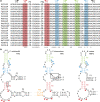
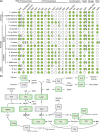


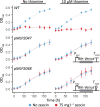
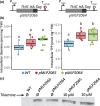
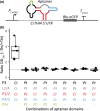

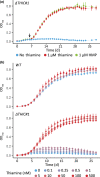
Similar articles
-
Comparative genomic analysis of fungal TPP-riboswitches.Fungal Genet Biol. 2018 May;114:34-41. doi: 10.1016/j.fgb.2018.03.004. Epub 2018 Mar 13. Fungal Genet Biol. 2018. PMID: 29548845
-
Alternatives to vitamin B1 uptake revealed with discovery of riboswitches in multiple marine eukaryotic lineages.ISME J. 2014 Dec;8(12):2517-29. doi: 10.1038/ismej.2014.146. Epub 2014 Aug 29. ISME J. 2014. PMID: 25171333 Free PMC article.
-
Identification and characterisation of thiamine pyrophosphate (TPP) riboswitch in Elaeis guineensis.PLoS One. 2020 Jul 29;15(7):e0235431. doi: 10.1371/journal.pone.0235431. eCollection 2020. PLoS One. 2020. PMID: 32726320 Free PMC article.
-
Exploring the structure, function of thiamine pyrophosphate riboswitch, and designing small molecules for antibacterial activity.Wiley Interdiscip Rev RNA. 2023 Jul-Aug;14(4):e1774. doi: 10.1002/wrna.1774. Epub 2023 Jan 2. Wiley Interdiscip Rev RNA. 2023. PMID: 36594112 Review.
-
Identification of novel ligands for thiamine pyrophosphate (TPP) riboswitches.Biochem Soc Trans. 2011 Apr;39(2):652-7. doi: 10.1042/BST0390652. Biochem Soc Trans. 2011. PMID: 21428956 Review.
Cited by
-
THI1 Gene Evolutionary Trends: A Comprehensive Plant-Focused Assessment via Data Mining and Large-Scale Analysis.Genome Biol Evol. 2024 Oct 9;16(10):evae212. doi: 10.1093/gbe/evae212. Genome Biol Evol. 2024. PMID: 39400049 Free PMC article.
-
Characterization of the dual regulation by a c-di-GMP riboswitch Bc1 with a long expression platform from Bacillus thuringiensis.Microbiol Spectr. 2024 Jul 2;12(7):e0045024. doi: 10.1128/spectrum.00450-24. Epub 2024 May 31. Microbiol Spectr. 2024. PMID: 38819160 Free PMC article.
-
Clustered Regularly Interspaced Short Palindromic Repeat/CRISPR-Associated Protein and Its Utility All at Sea: Status, Challenges, and Prospects.Microorganisms. 2024 Jan 6;12(1):118. doi: 10.3390/microorganisms12010118. Microorganisms. 2024. PMID: 38257946 Free PMC article. Review.
-
Whole cell affinity for 4-amino-5-hydroxymethyl-2-methylpyrimidine (HMP) in the marine bacterium Candidatus Pelagibacter st. HTCC7211 explains marine dissolved HMP concentrations.Environ Microbiol Rep. 2024 Oct;16(5):e70023. doi: 10.1111/1758-2229.70023. Environ Microbiol Rep. 2024. PMID: 39367564 Free PMC article.
-
CRISPR-based bioengineering in microalgae for production of industrially important biomolecules.Front Bioeng Biotechnol. 2023 Oct 26;11:1267826. doi: 10.3389/fbioe.2023.1267826. eCollection 2023. Front Bioeng Biotechnol. 2023. PMID: 37965048 Free PMC article. Review.
References
-
- Beilharz TH, Preiss T. 2009. Transcriptome‐wide measurement of mRNA polyadenylation state. Methods 48: 294–300. - PubMed
Publication types
MeSH terms
Substances
Grants and funding
- BB/L002957/1/BB_/Biotechnology and Biological Sciences Research Council/United Kingdom
- BB/M011194/1/BB_/Biotechnology and Biological Sciences Research Council/United Kingdom
- BB/M018180/1/BB_/Biotechnology and Biological Sciences Research Council/United Kingdom
- BB/R021694/1/BB_/Biotechnology and Biological Sciences Research Council/United Kingdom
LinkOut - more resources
Full Text Sources

